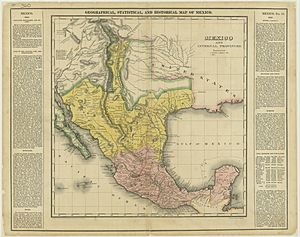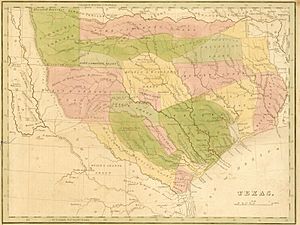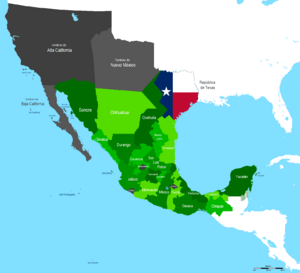Mexican Texas facts for kids
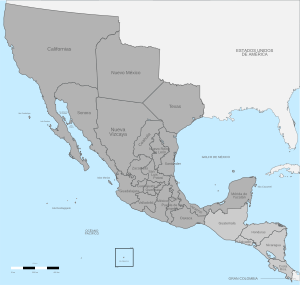
Mexican Texas was the name for the Texas area between 1821 and 1836. During this time, it was part of Mexico. Mexico became independent in 1821 after winning its war against Spain. This war started in 1810. At first, Mexican Texas worked much like it did under Spanish rule. In 1824, Mexico created a federal government. The area of Tejas (Texas) joined with the area of Coahuila to form the state of Coahuila y Tejas.
In 1821, about 3,500 people lived in Tejas. Most lived in San Antonio and La Bahia. The government wanted more settlers, especially along the border. Native American groups greatly outnumbered the settlers. To get more people, Mexico passed the General Colonization Law in 1824. This law allowed any head of a household to get land in Mexico. It didn't matter what their race, religion, or background was.
The first large land grant was given to Stephen F. Austin by Spain. His settlers, called the Old Three Hundred, arrived in 1822. They settled along the Brazos River. The Mexican government later approved this land grant. Twenty-three other land agents, called empresarios, also brought settlers. Most of these settlers came from the southern United States. Only one colony was settled by Mexican citizens. Two were settled by European immigrants.
Mexican officials soon worried about the Anglo-Americans in Tejas. For example, they insisted on bringing slaves into the area. In 1830, the government passed a law that stopped more U.S. citizens from moving there. New forts were built to watch immigration and trade. Angry colonists held a meeting in 1832. They demanded that U.S. citizens be allowed to move to Tejas again. At another meeting the next year, colonists suggested Texas become its own Mexican state. Mexico tried to make the colonists happy. But Antonio López de Santa Anna began changing Mexico from a federal system to a central one. This seemed to be the main reason for the Anglo-Texan revolt.
The first fight happened on June 26, 1832, at the Battle of Velasco. On March 2, 1836, Texans declared their independence from Mexico. The Texas Revolution ended on April 21, 1836. Santa Anna was captured by Texans after the Battle of San Jacinto. Texas declared itself the Republic of Texas. However, Mexico refused to recognize Texas as a new country.
Contents
Mexico Becomes Independent
In 1821, Mexico won its independence from Spain. The war was long and difficult. Mexico's new territory included much of what was once New Spain, including Spanish Texas. The winning rebels created a temporary constitution called the Plan de Iguala. This plan kept many ideas from the Spanish Constitution of 1812. It also gave equal rights to people of all races.
At first, leaders disagreed about Mexico's government. Should it be a federal republic or a monarchy (ruled by a king)? The first ruler, Agustín I of Mexico, stepped down in March 1823. The next month, people in San Antonio de Bexar formed a committee to govern Texas. It had seven members from San Antonio, one from La Bahia, and one from Nacogdoches. In July, a new national government named Luciano Garcia as the political leader of Texas.
On November 27, 1823, Mexicans elected new leaders. They wanted to create a new constitution. Texas was represented by Erasmo Seguin. A new Mexican constitution was approved on October 4, 1824. It made Mexico a federal republic with 19 states and four territories. The constitution was like the U.S. Constitution. But the Mexican one made Roman Catholicism the only official religion.
Texas had very few people. So, it was joined with Coahuila to form the state of Coahuila y Tejas. Texas had wanted to be its own territory. But then leaders realized that states controlled their own public lands. As a territory, the national government would control the land. So, Seguin decided not to ask for territory status. Congress did allow Texas to form its own state "as soon as it feels capable of doing so."
The new state was the poorest in Mexico. It covered the same area as Spanish Texas. But it did not include El Paso, which belonged to Chihuahua. And it didn't include Laredo, Texas, which became part of Tamaulipas. The capital of Texas moved from San Antonio to Monclova, then to Saltillo. Coahuila y Tejas, Tamaulipas, and Nuevo León were all under one military group. When the new state government formed, the Texas governing committee had to stop. Many Tejanos (Texans of Mexican heritage) didn't want to give up their self-rule.
The 1824 constitution ended the mission system. Missions older than ten years had to become regular churches. Newer missions had until 1842 to become secular (non-religious). Most missions were already secular by the 1820s. Only Missions Refugio, Espiritu Santo, and Rosario were still missions. By 1830, these missions became churches. Most Native Americans from the missions moved to other Texas settlements. As missions became secular, their lands were given to Native Americans. These people would later pay taxes on their profits.
The new Mexican government had no money. It couldn't pay for a large army. Settlers were allowed to create their own militias. These groups helped control hostile Native American tribes. Texas faced attacks from both the Apache and Comanche tribes. With little army support, the few settlers needed help. The government hoped more settlers would stop the Indian raids. So, it made immigration rules easier for the first time. Settlers from the United States were allowed in the colonies.
New Settlers Arrive
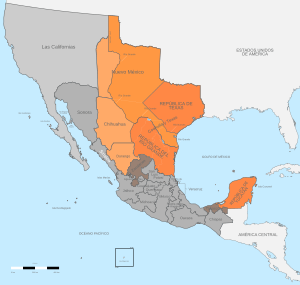
In the late 1700s, Spain stopped giving out new land in San Antonio and La Bahia. This made it hard for families to grow. People in northeast Texas could live on land, but they didn't officially own it. Just before Mexico became independent, Spain changed its rules. It passed a colonization law. This law didn't say settlers had to be Catholic. But Spain's only religion was Catholicism, so it was understood. This law also said no slaves could be brought into Spanish lands. If they were, they would be freed.
Mexico passed a similar law in 1824. The General Colonization Law allowed any head of a household to claim land. This included Mexican citizens and immigrants. The law treated all races and social classes the same. People already living on land could now officially own it. Unlike the Spanish law, the Mexican law required immigrants to be Catholic. It also said foreigners needed to learn Spanish. Settlers were supposed to own property or have a useful job. Everyone wanting to live in Texas had to ask Mexican authorities for permission. But these rules were often ignored. Many families just settled without permission.
After the national colonization law passed, the state government in Saltillo approved settlement contracts for Texas. Many foreign land agents wanted to bring colonists. Coahuila y Tejas put the federal law into action in 1825. At this time, about 3,500 people lived in Texas. Most were in San Antonio and La Bahia. Under the new law, people who didn't own land in Texas could claim a large piece of land. Soldiers got first choice of land, then citizens, then immigrants. Land agents and large families could get more land. People who owned land under Spanish rule could keep it. This was true as long as they didn't fight for Spain in the war. Immigrants had the same rules as Mexican citizens. Native Americans who moved to Texas after independence were treated as immigrants.
About 3,420 land requests came from immigrants and new citizens. Many were Anglo-Americans. The first group, the Old Three Hundred, arrived in 1822. They settled on land given to Stephen F. Austin by Spain. They settled along the Brazos River, near where Houston and Dallas are today. Soon after they arrived, Austin learned the new Mexican government hadn't approved his father's land grant. He had to travel 1,200 miles to Mexico City to get permission. While there, Austin impressed government leaders. He offered to draw a map of Texas and help clear the Colorado River. He also promised to help stop Indian attacks.

On February 18, 1823, Agustin I approved Austin's contract. One month later, Agustin stepped down as emperor. The new government canceled all his acts, including Austin's contract. But Austin's friends in Mexico praised him. His contract was approved again in mid-April. When he returned to Texas in July 1823, Austin set up San Felipe de Austin as his colony's main town.
Many people wanted to come to Texas. The United States was still recovering from a money crisis in 1819. Land prices in the U.S. were very high. So, Mexico's land policy seemed very generous. In 1827, Austin got a second grant. This allowed him to settle 100 families along the Old San Antonio Road near Bastrop. Tejanos wanted settlers there to help defend against Comanche raids. Austin later got permission to settle 800 more families.
Twenty-three other land agents also brought immigrants to Texas. Only one, Martín De León, settled Mexican citizens. The others mainly brought people from the United States. Many Anglo settlers owned slaves. All colonists were expected to become Mexican citizens. They were also supposed to follow the state religion. In Austin's colony, the local priest officially converted new arrivals. But then he let them worship as they wished.
Austin was made a lieutenant colonel in the militia. He had full power over justice, except for serious crimes. To keep order, he wrote the first Anglo-American law code in Texas. His "Instructions and Regulations for the Alcades" came out on January 22, 1824. It included rules for crimes and court procedures. It set up sheriff and constable offices and a basic court system. It used English common law ideas for defining crimes. It also set punishments for things Austin thought were disruptive.
Land agents were responsible for safety in their lands. In 1823, Austin created a group of men to patrol his colony. They protected settlers from Native attacks and solved problems. This first group, called the Ranger Company, had 10 volunteers. They served for 3-6 months and were paid in land. They didn't wear uniforms and weren't under military law. They were the start of the Texas Rangers. After the Karankawa tribe attacked settlers many times, Austin organized a militia. They fought back and almost wiped out the tribe.
Comanches were a threat to some colonies. Green Dewitt started his colony west of Austin's in December 1825. In July 1826, his main town, Gonzales, was burned by a Comanche attack. All but one colonist escaped to San Felipe. They returned to rebuild their colony the next year. For protection, the political leader gave the community a small cannon.
Land speculators came to Texas in large numbers. Colonization laws limited Anglos to one large piece of land. But Mexican citizens could often get up to 11 pieces. Anglo speculators would often convince a Mexican citizen to claim their 11 pieces. Then they would buy the land from them.
Growing Problems
In 1825, Mexican officials worried about land agent Haden Edwards in Nacogdoches. Edwards threatened to take land from any Mexican already living in his settlement area. He said they had to show written proof of ownership. Mexican officials quickly told him he couldn't take land. They said he must respect the claims of earlier settlers. After many arguments, on December 16, 1826, Edwards and 30 settlers declared independence. They called themselves the Republic of Fredonia. Other land agents did not support Edwards. Austin sent 250 militiamen to Nacogdoches to help Mexican forces stop the revolt. Edwards finally had to flee Mexican territory.
The Mexican government heard about other racial problems. So, they asked General Manuel Mier y Teran to check on the 1825 colonization law in Texas. In 1829, Mier y Teran reported his findings. He said most Anglo Americans refused to become citizens. They also tried to stay separate from Mexicans. He noted that laws about slavery were being ignored.
Many Mexicans wanted to end slavery. But they feared an economic crisis if all slaves were freed at once. So, they planned to free slaves slowly. In 1823, Mexico banned buying or selling slaves. It also said children of slaves must be freed at age fourteen. Any slave brought into Mexico by buying or trading would also be freed. By 1825, a count in Austin's Colony showed 1,347 Anglo-Americans and 443 people of African descent. This included a few free African Americans. Two years later, the state of Coahuila y Tejas banned bringing more slaves into the state. It also said all children born to a slave would be free at birth. New laws also said any slave brought into Texas should be freed within six months.
In 1829, slavery was officially outlawed in Mexico. Austin worried this would cause widespread anger. He tried to stop the news from spreading. But rumors of the new law quickly reached the area. Colonists seemed ready to revolt. The governor of Coahuila y Tejas, Jose Maria Viesca, wrote to the president. He explained how important slavery was to the Texas economy. He also stressed how important the Texas economy was to the state's growth. Texas was temporarily allowed to keep slavery. On April 6, 1830, Mexican president Anastasio Bustamante ordered Texas to follow the emancipation law. If not, the army would get involved.
To get around the law, many Anglo colonists made their slaves "indentured servants for life." Others just called their slaves indentured servants without changing their legal status. Slaveholders wanting to enter Mexico made their slaves sign contracts. These contracts said the slaves owed money and would work to pay the debt. The low wages made repayment impossible. The debt would be passed down, even though no slave would get wages until age eighteen. A state law in 1832 banned worker contracts lasting more than ten years. A small number of slaves were brought in illegally from other places. By 1836, there were about 5,000 slaves in Texas.
Areas with slaves exported more goods than areas without slaves. A study of Texas in 1834 found that the Bexar area, mostly Tejanos, exported no goods. The Brazos area, including Austin's colonies, exported goods worth 600,000 pesos. This included 5,000 bales of cotton. The Texas area, with eastern settlements, expected to export 2,000 bales of cotton and 5,000 cattle.

Bustamante took other steps to make immigration less appealing for Anglo-Americans. He ended the property tax law. This law had let immigrants avoid taxes for ten years. He also raised taxes on goods coming into Mexico from the United States. This made prices go up. The 1830s laws also put settlement contracts under federal control, not state control. Colonies that didn't have at least 150 people would be canceled. This affected colonies run by Sterling C. Robertson and the Galveston Bay and Texas Land Company. Finally, he banned further immigration to Texas from the United States. Anglos were still welcome in other parts of Mexico.
The ban and other rules did not stop U.S. citizens from illegally moving to Texas by the thousands. By 1834, it was thought that over 30,000 Anglos lived in Texas. There were only 7,800 Mexicans.
Anglos often saw Mexicans as outsiders. Mexicans often felt the same way about Anglos. Rafael Antonio Manchola, a Mexican official, warned the military leader for Texas: "No trust can be placed in the Anglo-American colonists. They keep showing that they refuse to follow rules. This is unless it helps what they want. I believe this will be very bad for us if they are our neighbors. We must stop their boldness by putting a strong army in each new settlement. This army will enforce the laws of a Mexican judge. Because under their own judges, they only use their own laws. They forget the laws they swore to obey, which are our government's laws."
International Concerns
Many Americans felt the United States had been cheated out of Texas. American land speculators thought they could get rich in Texas. American politicians believed Texas could help keep a balance between free and slave states. In 1827, U.S. president John Quincy Adams offered $1 million for Texas. Mexican president Guadalupe Victoria said no. Two years later, Andrew Jackson offered $5 million. President Vicente Guerrero again refused to sell.
In July 1829, Mexican officials had other worries. General Isidro Barradas landed 2,700 Spanish troops near Tampico. They tried to take Mexico back for Spain. The government asked Austin to gather a local militia. This group would help defend Texas if the invasion reached the north. Yucatán governor Antonio López de Santa Anna led Mexican troops to stop the invasion. Barradas surrendered because his troops got sick from tropical diseases. Santa Anna was seen as a hero. During the invasion, the Mexican Congress gave President Guerrero war powers. This made him almost like a king. This worried the Anglo colonists in Texas. They were used to a government with separate powers.
Steps Toward Revolt
Mier y Teran's 1828 report suggested new army posts in Texas. These posts would watch the Anglo colonists. They would also encourage Mexicans to move to the area. The new posts would be partly staffed by prisoners. The first was built on Galveston Bay in 1831 at Anahuac. It became the first port in Texas to collect customs taxes. A second customs port, Velasco, was built at the mouth of the Brazos River. A third army post, Fort Teran, was built on the Neches River. This was to stop smuggling and illegal immigration.
Mier y Teran also ordered the army post at Bexar to leave their fort. They were to build a new one. Fort Tenoxtitlán was built in 1830 on the west bank of the Brazos River. It was 100 miles above San Felipe. Soon after the fort was finished, 50 immigrants from Tennessee arrived. They came with land agent Sterling C. Robertson. These settlers had arrived illegally. Robertson's contract had been canceled by Guerrero's 1830 laws. The fort commander chose not to send them away. Instead, he asked Mexico for advice. Three months later, he was told to expel the settlers right away. He still chose not to. This saved the Robertson's Colony. The fort closed in 1832. The commander ordered all soldiers to return to San Antonio.
Anahuac was controlled by Colonel Juan Davis Bradburn. Bradburn strictly enforced the 1830 laws. This angered many colonists. He stopped the state official from giving land titles to people who settled without permission. He also insisted on enforcing the law that freed any slave who entered Mexican territory. He and his men also took settlers' goods for themselves. This angered many Anglos. They believed their rights under the Mexican Constitution of 1824 were being broken. In 1832, local men formed a militia. They said it was to protect the settlement from Indian attacks. But all Indians in the area were peaceful. Mexican law banned residents from forming militias. So, Bradburn arrested the leader, Patrick C. Jack. Citizens were very angry. In Brazoria, residents held a town meeting. They wanted to decide what to do. William H. Wharton said there wasn't much support in Austin's colony to fight Bradburn with force. He and others who wanted to fight felt that other settlers opposed them as much as the Mexican soldiers did. Bradburn eventually agreed to release Jack. Tensions calmed for a short time.
In May 1832, Bradburn got a letter. It seemed to be from a friend. It warned that 100 armed men were 40 miles away. They planned to get back runaway slaves held by Bradburn. Bradburn realized the letter was a trick. He arrested Travis for questioning. He planned to send Travis to Matamoros for a military trial. The charge was trying to start a rebellion to separate from Mexico. If found guilty, Travis would surely be executed. The settlers were very angry. The arrest didn't need a warrant, a list of charges, or a trial by jury. Most didn't know Mexican law. They thought the United States Bill of Rights still applied to them. Settlers attacked the Anahuac army post to free Travis. This event became known as the Anahuac Disturbances.
More settlers gathered in Brazoria. They wanted to transport cannons to help the group in Anahuac. Colonel Domingo de Ugartechea led the army post at Velasco. This was at the mouth of the Brazos River. He refused to let the ship carrying the cannons pass. On June 26, settlers started the Battle of Velasco. Ugartechea surrendered the next day.
Several days later, Colonel Jose de las Piedras arrived from Nacogdoches to help Bradburn. He removed Bradburn from his command. The settlers then left.
In 1832, Antonio López de Santa Anna led a revolt against Mexican president Bustamante. Most of the Mexican Army supported Bustamante. This led to a small civil war. Many Anglo settlers sided with Santa Anna. They followed General José Antonio Mexía, who led soldiers in Texas against Bustamante. Mexia removed the commander at Matamoros. In October, 55 delegates from Texas communities met at the Convention of 1832 in San Felipe. The delegates wrote three requests to the Mexican Congress. They wanted to cancel Article 11 of the 1830 colonization law. This law banned foreign settlement and customs reform. They also wanted people who settled without permission to be recognized as valid immigrants. And they wanted Texas to be a separate state.
On December 19, 1832, the Bexar Remonstrance was sent to the Mexican Congress. It officially listed the problems Texans had under the central Mexican government. It talked about issues like poor protection from Indian attacks. It also mentioned low pay for militias, not enough local leaders, banning immigration from the United States, and a lack of schools. It also pointed out many times the government broke the republican Constitution of 1824.
Santa Anna was elected president of Mexico on January 19, 1833. A second convention was held in April that year. Newcomers like Sam Houston attended. They chose a group to write a constitution for a new Mexican state of Texas. They also picked people to represent Texas to the federal government. Austin was chosen to take the proposed constitution to Santa Anna's government in Mexico City. Austin said Texas had permission to form a separate state. He also said it now had 46,500 people. But the political leader of Bexar warned the government. He said Anglos might want separate statehood to join the United States. Austin was arrested on November 21, 1833, for suspected treason. Austin was in prison for about a year. Santa Anna decided to get rid of the Mexican Constitution of 1824 and became a ruler. At this point, Austin changed his mind. He went from wanting peace to supporting separation from Mexico.
The Mexican government tried to fix some of the Texans' problems. Article 11 was canceled on November 21, 1833. This allowed American immigrants to come to Texas again. Five months later, Coahuila y Tejas divided Texas into three areas: San Antonio-Bexar, Brazos, and Nacogdoches. Each area had political leaders and more say in the state government. Also, trial by jury was started. English was allowed as a second language. An Anglo American, Jefferson Chambers, was made a top judge in Texas in 1835. Extensions were given for settlement contracts that hadn't met their settler numbers. Six English-speaking Texan communities became official towns.
In March 1833, the state capital moved from Saltillo to Monclova. The next year, centralist leaders urged Santa Anna to end the federal system and start central rule. Some lawmakers believed central rule was the only way to keep Texas. Newspapers in the United States kept talking about Texas joining the U.S. When the national congress tried to centralize the nation, a civil war started. As fighting broke out, Saltillo said Monclova was illegally made the capital. It chose its own governor. Texans in Saltillo suggested setting up a temporary government in Bexar during the unrest. This would make Texas more independent. Juan Seguin, political leader of Bexar, called a town meeting to create a government. But he had to postpone it when news of approaching Mexican troops arrived.
By the end of the year, Santa Anna started acting like a central ruler. In 1835, he canceled the Constitution of 1824. He began taking more power for himself. In different parts of the country, federalists revolted. In May 1835, Santa Anna brutally crushed a revolt in Zacatecas. Over 2,000 non-soldiers were killed. Federalists, including Agustín Viesca, the governor of Coahuila y Tejas, were afraid. They thought Santa Anna would march against Coahuila after stopping the rebels in Zacatecas. So, they ended the state government on May 21, 1835. They allowed the governor to set up an office in another part of the state. Viezca was arrested as he traveled to San Antonio. The people of Anahuac organized a resistance under Travis. They said they were angry about Viezca's imprisonment. But their real complaint was that the two-year tax break had ended. The Anahuac customs office had reopened. When Viezca escaped and reached Texas, no one recognized him as governor. As protests spread across Texas, Mexican officials increasingly blamed settlers from the United States for the problems.
The Texas Revolution Begins
In January 1835, Austin published his "Exposition to the Public Regarding the Affairs of Texas." He wanted to be free. In this paper, he explained that Texas wanted to be a separate state, not an independent country. He talked about the problems with the Texas justice system. He said the meetings of 1832 and 1833 were "an exercise of the right to petition that belongs to every free people." He was finally released from prison and returned to Texas by August. His time in prison changed his mind about Texas's future. He called for Texans to fight. He announced that Texas should be "forever free of any Mexican control."
After the Mexican Congress elected Antonio López de Santa Anna as President in 1833, he appointed Valentín Gómez Farías as his vice president. Santa Anna gave him much of the governing power. However, the Vice President started making changes. These changes especially affected the Mexican Army and the Catholic Church. These changes angered powerful centralist groups. They urged Santa Anna to return from his semi-retirement. Santa Anna agreed. He led the reaction against these changes. He forced Gómez Farías and his supporters, including Mexican General José Antonio Mexía, to leave Mexico. Some went to New Orleans. There, they planned to fight the centralist government.
The United States government officially stayed neutral in the fight between Santa Anna's Centralists and Gomez Farias' Federalists. But many people in the U.S. wanted Texas to separate from Mexico. Many men, called "filibusterers," joined groups like the New Orleans Greys. They prepared to fight for Texas independence. General Mexia soon found money in New Orleans. He began gathering an army to attack the important Mexican port of Tampico. He convinced important people in New Orleans that taking the port would help Texas. However, the "Tampico Expedition" he started on November 6, 1835, failed.
In 1835, Juan Seguin, Plácido Benavides, Manuel Leal, and Salvador Flores began gathering volunteer groups. These groups were from the San Antonio and Victoria areas. They wanted to support the federalist cause. By the end of the year, over 100 Tejanos had joined the Federal Army of Texas. They wanted to defend the Constitution of 1824 against the centralists. The political leader of the Nacogdoches area told the militias to take up arms against Mexican troops in July 1835. He asked other citizens to form a volunteer army. "Texas committees" in cities like New Orleans and New York City gathered volunteers. They began sending an army and money to help the Texas colonists fight. Austin commanded the militias. Sam Houston was in charge of the volunteers. The first violent event happened on October 2 at the Battle of Gonzales.
The Consultation met in November. They discussed the reasons for the revolt. The Consultation spoke out against central rule. They organized a temporary state government. This government was based "on the principles of the 1824 Constitution." The next month, San Antonio surrendered to the Anglos. This gave the rebels a lot of military equipment. Some Texans traveled to the United States to ask for help. They didn't get a loan. But they managed to advertise that land was available in Texas. This made sure more volunteers would come to fight.
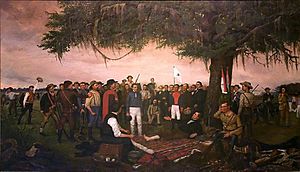
Texas officially declared independence at Washington-on-the-Brazos on March 2, 1836. They said the revolt was needed to protect basic rights. They also said Mexico had canceled the federal agreement. The colonists said Mexico had invited them to move to the country. They were determined "to enjoy 'the republican institutions to which they were accustomed in their native land, the United States of America.'" The declaration did not admit that Mexico had tried to meet some of their demands. The new Texas constitution specifically allowed slavery. It also said no free person of African descent could live in the new country without Congress's permission. Many Tejanos left the fight after the declaration of independence. They were disappointed with the growing anti-Mexican talk. Only Seguin's company stayed in the Texian Army.
The war ended with the Battle of San Jacinto on April 21, 1836. This led to the birth of the Republic of Texas. Santa Anna was captured. Mexican troops had to go south of the Rio Grande. It was amazing that Sam Houston stopped the Texans from killing Santa Anna. Santa Anna had killed the men of the Alamo and Goliad. In the Treaties of Velasco that followed, Santa Anna promised to convince the Mexican government to recognize Texas's independence. Santa Anna was released to the United States. The U.S. then gave him back to Mexico. The new president of Mexico (Anastasio Bustamante) and the Mexican Congress both rejected the Treaties of Velasco. They said Santa Anna signed them under force, so they were not valid. Santa Anna later said, "I did promise to try to get a hearing for the Texas Commissioners, but this in itself did not bind the government to receive them."
See also
 In Spanish: Texas (México) para niños
In Spanish: Texas (México) para niños


